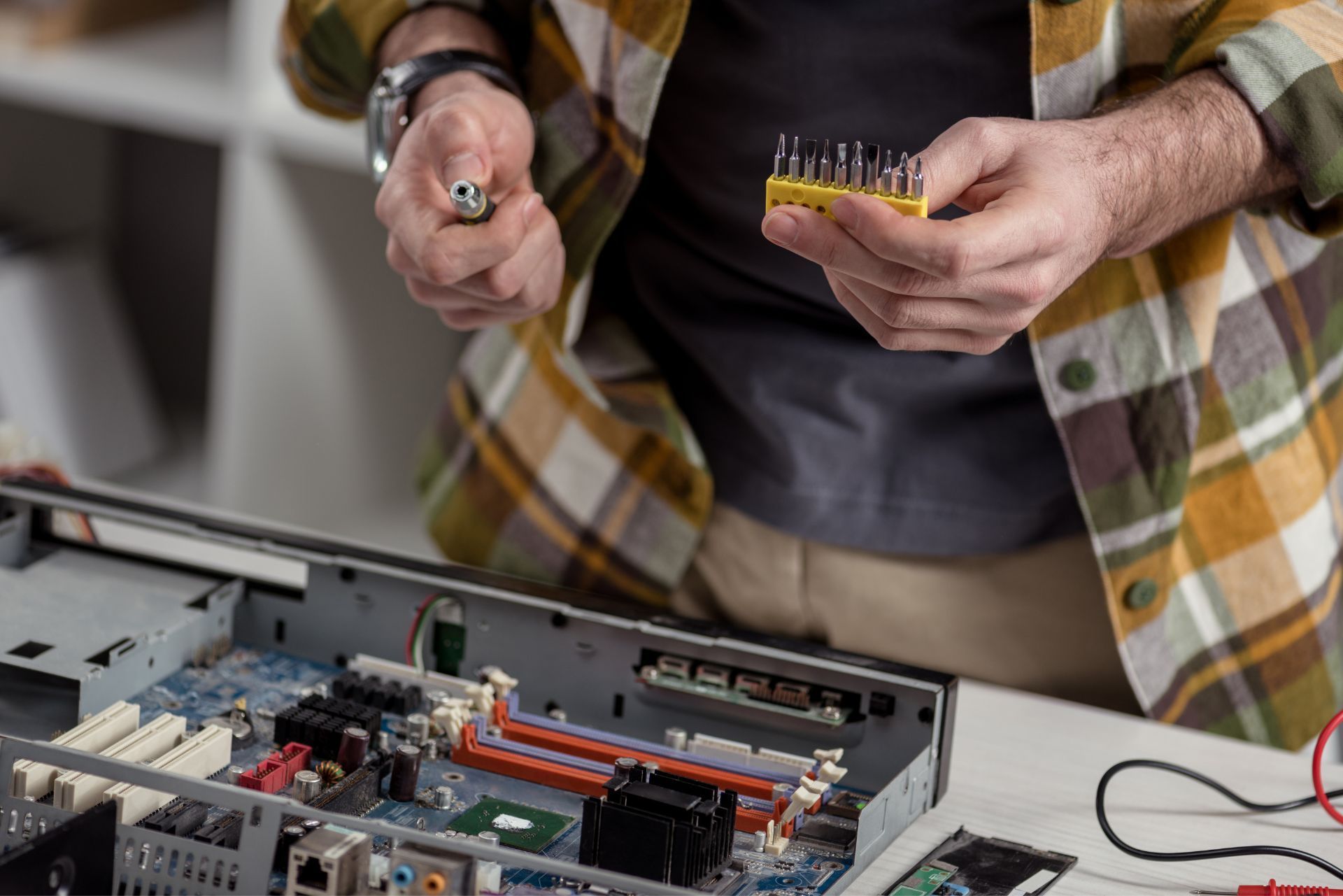Texas Electronics Equipment Insurance for Business

See How We're Different
or call us: (855) 359-9324
Top 3 Recommended Policies
Index
Understanding Electronics Equipment Insurance
Types of Electronics Equipment Insurance Policies Available in Texas
Key Considerations When Purchasing Electronics Equipment Insurance in Texas
How to Choose the Right Insurance Provider in Texas
Steps to Obtain Electronics Equipment Insurance in Texas
Common Challenges and How to Overcome Them
Real-Life Examples of Electronics Equipment Insurance in Action
Contact Us
In today’s fast-paced business environment, electronics equipment is the backbone of many Texas enterprises. From computers and servers to specialized machinery and communication devices, these assets are critical to daily operations. However, with the increasing reliance on technology comes the risk of damage, theft, or malfunction, which can disrupt business continuity and lead to significant financial losses. This is where Texas electronics equipment insurance steps in, providing essential protection tailored to the unique needs of businesses across the state.
Understanding Electronics Equipment Insurance
Electronics equipment insurance is a specialized type of coverage designed to protect a business’s electronic assets from a range of risks. Unlike general property insurance, this policy focuses specifically on the technology and electronic devices that are vital to business operations.
In Texas, where industries such as technology, manufacturing, healthcare, and energy heavily depend on sophisticated electronics, this insurance is particularly important. It covers everything from laptops and mobile devices to complex industrial machinery and data servers. As businesses increasingly rely on technology to enhance productivity and efficiency, the need for comprehensive coverage becomes even more critical to safeguard against unforeseen incidents.
What Does Electronics Equipment Insurance Cover?
Policies vary, but typically, electronics equipment insurance covers:
- Physical damage: Protection against accidental damage, including drops, spills, and electrical surges.
- Theft and vandalism: Coverage if equipment is stolen or intentionally damaged.
- Mechanical breakdown: Repairs or replacement costs when equipment fails due to mechanical or electrical issues.
- Natural disasters: Damage caused by events such as floods, fires, or storms, which are relevant given Texas’s vulnerability to hurricanes and severe weather.
- Business interruption: Some policies include coverage for lost income if equipment failure disrupts operations.
It's important to review the specific terms of a policy, as coverage limits, deductibles, and exclusions can vary significantly between providers. Additionally, businesses may want to consider endorsements or riders that can enhance their coverage, such as data recovery services or coverage for newly acquired equipment, ensuring that they are fully protected as their technology needs evolve.
Why Texas Businesses Need Electronics Equipment Insurance
Texas is home to a diverse business landscape, ranging from small startups in Austin’s tech scene to large oil and gas companies in Houston. Regardless of size or industry, electronics equipment is a critical asset that requires protection.
According to the Texas Department of Insurance, electronic equipment claims have seen a steady increase over the past five years, reflecting the growing dependence on technology. Additionally, Texas’s exposure to natural disasters such as hurricanes and tornadoes increases the risk of equipment damage. The state’s rapid economic growth and technological advancement mean that businesses must stay ahead of potential risks to maintain their competitive edge.
Without proper insurance, businesses face the risk of costly repairs or replacements, operational downtime, and potential loss of data, all of which can severely impact profitability and reputation. Moreover, the financial implications of a major equipment failure can be devastating, especially for small to medium-sized enterprises that may not have the capital reserves to absorb such shocks. Investing in electronics equipment insurance not only mitigates these risks but also provides peace of mind, allowing business owners to focus on growth and innovation rather than worrying about unforeseen setbacks.

Types of Electronics Equipment Insurance Policies Available in Texas
Choosing the right insurance policy depends on the type of electronics equipment, the nature of the business, and the specific risks involved. Here are the main types of policies commonly available:
1. Inland Marine Insurance
Inland marine insurance is designed to cover movable property, including electronics equipment that is frequently transported or used off-site. For businesses that rely on mobile devices, laptops, or portable diagnostic tools, this type of insurance provides flexible protection.
For example, a Texas-based IT consulting firm that sends technicians to client locations would benefit from inland marine coverage to safeguard their equipment during transit and on-site use. Additionally, this insurance can also cover equipment that is temporarily stored at a location other than the primary business premises, ensuring that businesses are protected even when their equipment is not in their immediate control. This is particularly useful for companies that may need to store equipment at job sites or partner locations, where the risk of theft or damage can be higher.
2. Equipment Breakdown Insurance
This policy covers the repair or replacement of equipment that breaks down due to mechanical or electrical failure. It often includes coverage for computers, servers, and specialized machinery.
Given the high cost of repairing industrial electronics or data center equipment, equipment breakdown insurance can save Texas businesses from unexpected expenses and prolonged downtime. Furthermore, many policies also cover the loss of income that can result from equipment failure, providing a financial safety net while repairs are underway. This aspect is crucial for businesses that rely heavily on their electronics for daily operations, as any interruption can lead to significant revenue loss and customer dissatisfaction.
3. Property Insurance Endorsements
Many businesses add electronics equipment coverage as an endorsement to their existing commercial property insurance. This option is convenient but may have limitations in coverage scope or limits.
Business owners should carefully assess whether an endorsement meets their needs or if a standalone electronics equipment policy is more appropriate. It's essential to understand the specific terms and conditions of endorsements, as they can vary widely between insurers. Some endorsements may exclude certain types of equipment or have lower coverage limits, which could leave businesses vulnerable in the event of a loss. A thorough review of the existing policy alongside potential endorsements can help ensure that all valuable electronics are adequately protected.
4. Cyber Insurance with Equipment Coverage
While primarily focused on data breaches and cyberattacks, some cyber insurance policies include coverage for electronic equipment damaged during a cyber incident, such as ransomware attacks that cause hardware failure.
Texas businesses in sectors like finance and healthcare, which handle sensitive data, may find this combined coverage beneficial. Moreover, as cyber threats continue to evolve, having a policy that addresses both data security and equipment protection can provide a comprehensive safety net. This is particularly relevant in today's digital landscape, where the interconnectivity of devices means that a cyber incident can have cascading effects on hardware, leading to costly repairs or replacements. By investing in cyber insurance with equipment coverage, businesses can not only protect their data but also ensure that their essential electronics remain operational in the face of potential cyber threats.
Key Considerations When Purchasing Electronics Equipment Insurance in Texas
Securing the right insurance policy requires careful evaluation of several factors to ensure comprehensive protection and cost-effectiveness.
Assessing Your Equipment Inventory and Value
Start by creating a detailed inventory of all electronics equipment, including purchase dates, values, and usage. This helps in determining the amount of coverage needed and ensures no asset is overlooked.
Texas businesses should also consider depreciation and replacement costs, especially for rapidly evolving technology that may require frequent upgrades. Additionally, it’s beneficial to categorize equipment based on its criticality to operations. For example, equipment that is essential for day-to-day functions may warrant higher coverage limits compared to less critical items. This strategic approach not only aids in accurate valuation but also helps in prioritizing insurance needs based on operational dependencies.
Understanding Coverage Limits and Deductibles
Coverage limits define the maximum amount an insurer will pay for a claim. Deductibles are the out-of-pocket expenses the business must pay before insurance kicks in.
Balancing these factors is crucial. Higher deductibles can lower premiums but increase upfront costs during a claim. Texas businesses should choose limits that reflect the true value of their equipment and potential loss impact. It may also be wise to consult with an insurance broker who specializes in electronics equipment to navigate the complexities of policy options and ensure that the selected limits align with industry standards and specific business needs.
Evaluating Risk Factors Specific to Texas
Texas’s unique climate and geographic risks should influence insurance decisions. For instance, businesses in coastal areas prone to hurricanes may require additional flood or windstorm coverage.
Similarly, urban businesses might prioritize theft and vandalism protection, while those in rural areas may focus on equipment breakdown due to power fluctuations or dust exposure. Furthermore, understanding local crime rates and environmental hazards can help tailor insurance coverage more effectively. For example, businesses in areas with high theft rates may benefit from enhanced security measures, which could potentially lead to lower premiums if documented and presented to insurers.
Checking for Exclusions and Additional Coverages
Insurance policies often exclude certain risks or require additional riders for specific coverage. Common exclusions include wear and tear, intentional damage, and certain natural disasters.
Texas businesses should review policies carefully to identify gaps and consider supplemental coverages such as data recovery, business interruption, or pollution liability if relevant. It’s also important to inquire about coverage for emerging risks, such as cyber threats, which can compromise electronic equipment and data integrity. Given the increasing reliance on technology, ensuring that your policy encompasses these modern challenges is crucial for maintaining operational resilience and safeguarding against unforeseen disruptions.

How to Choose the Right Insurance Provider in Texas
Selecting a reputable and experienced insurance provider is as important as choosing the right policy. Here are key factors to consider:
Industry Expertise and Local Knowledge
Providers with experience in Texas’s business environment and familiarity with local risks can offer tailored advice and coverage options. They understand the regulatory landscape and can assist with compliance requirements. For instance, Texas is prone to unique weather events like hurricanes and tornadoes, which can significantly impact property and business insurance needs. A knowledgeable provider will not only help you navigate these risks but also suggest specific endorsements or riders that can enhance your coverage against such natural disasters.
Claims Handling and Customer Service
Efficient claims processing and responsive customer service are critical during stressful situations. Research customer reviews and ask for references to gauge the insurer’s reputation. Additionally, consider the availability of support channels; some providers offer 24/7 customer service, which can be invaluable when you need immediate assistance. A strong claims support team can make a significant difference in how quickly and smoothly your claim is processed, ensuring you receive the help you need without unnecessary delays.
Financial Stability
Ensure the insurer has strong financial ratings from agencies like A.M. Best or Standard & Poor’s, indicating their ability to pay claims promptly. A financially stable company is more likely to be around in the long term, which is particularly important for policies that may span several years. You might also want to review the insurer’s history of claims payouts and any financial reports available to the public, as these can provide further insight into their reliability and trustworthiness.
Competitive Pricing and Flexible Terms
Compare quotes from multiple providers to find competitive premiums. Look for flexibility in policy terms, such as customizable coverage limits and deductible options. It’s also worth considering any discounts that may apply, such as bundling multiple policies or maintaining a claims-free record. Furthermore, understanding the fine print of each policy can help you identify any hidden fees or exclusions that could affect your overall costs and coverage. Engaging in discussions with potential insurers about your specific needs can lead to better-tailored solutions that fit your budget and provide the protection you require.
Steps to Obtain Electronics Equipment Insurance in Texas
Acquiring electronics equipment insurance involves a straightforward process, but preparation can streamline it significantly.
1. Conduct a Risk Assessment
Evaluate the types of electronics equipment used, potential risks, and financial exposure. This assessment helps in selecting appropriate coverage. Consider factors such as the age and condition of the equipment, the environment in which it operates, and the frequency of use. Additionally, think about the specific threats your business may face, such as theft, accidental damage, or natural disasters like floods or fires. A comprehensive risk assessment not only aids in determining the right coverage but also highlights areas where you might need to improve safety protocols.
2. Gather Documentation
Prepare an inventory list, purchase receipts, maintenance records, and any existing insurance policies. Detailed documentation supports accurate underwriting and claims. It’s beneficial to categorize your equipment by type and value, as this will help insurers understand your needs better. Furthermore, keeping maintenance records can demonstrate that you have taken proper care of your equipment, which may positively influence your premium rates. Don’t forget to include any warranties or service agreements, as these can also play a role in your insurance considerations.
3. Request Quotes and Compare Policies
Contact multiple insurance providers or brokers specializing in Texas business insurance. Compare coverage details, exclusions, premiums, and service terms. When requesting quotes, be transparent about your business operations and the specific risks you identified during your assessment. This openness will allow insurers to provide you with the most accurate and relevant quotes. Additionally, consider the reputation of the insurance companies you are evaluating; customer reviews and ratings can provide insight into their claims process and overall service quality.
4. Customize Your Policy
Work with the insurer to tailor the policy to your business needs, adding endorsements or riders as necessary. Customization can include options for business interruption coverage, which protects against loss of income due to equipment failure, or coverage for data loss if your electronics store sensitive information. Discussing your unique operational needs with the insurer can help ensure that you are not underinsured or overpaying for unnecessary coverage. It’s essential to ask about any available discounts for bundling policies or implementing risk management practices.
5. Review and Finalize
Carefully review the policy documents before signing. Ensure all verbal agreements are included in writing. Pay close attention to the fine print, particularly regarding exclusions and limitations of coverage. It may also be beneficial to consult with a legal or insurance professional to clarify any terms you do not understand. Once you’re satisfied with the policy, ensure that you keep a copy in a secure location and set reminders for when it’s time to renew or reassess your coverage, as your business needs may evolve over time.
Common Challenges and How to Overcome Them
While electronics equipment insurance provides valuable protection, Texas businesses may face challenges during the process.
Underinsurance
Underestimating the value of electronics equipment can lead to insufficient coverage. Regularly updating equipment inventories and policy limits helps avoid this issue.
Policy Exclusions
Unfamiliarity with policy exclusions can result in denied claims. Businesses should seek clarification from insurers and consider additional coverage where needed.
Claims Disputes
Disagreements over claim settlements can arise. Maintaining thorough records and working with experienced insurance agents can facilitate smoother resolutions.
Real-Life Examples of Electronics Equipment Insurance in Action
Consider a Houston-based medical device company whose critical diagnostic equipment was damaged during a severe thunderstorm. Thanks to their electronics equipment insurance policy, they were able to quickly repair the devices and resume operations without significant financial strain.
Similarly, an Austin IT firm experienced a ransomware attack that caused hardware failure. Their combined cyber and electronics equipment insurance covered the replacement costs and mitigated business interruption losses.
Conclusion
For Texas businesses, electronics equipment insurance is not just a safety net—it’s a strategic investment in operational resilience. With the state’s diverse economy and exposure to various risks, protecting electronic assets ensures continuity, reduces financial uncertainty, and supports long-term growth.
By understanding the types of coverage available, assessing specific business needs, and choosing the right provider, Texas enterprises can safeguard their technology investments and focus confidently on innovation and success.





